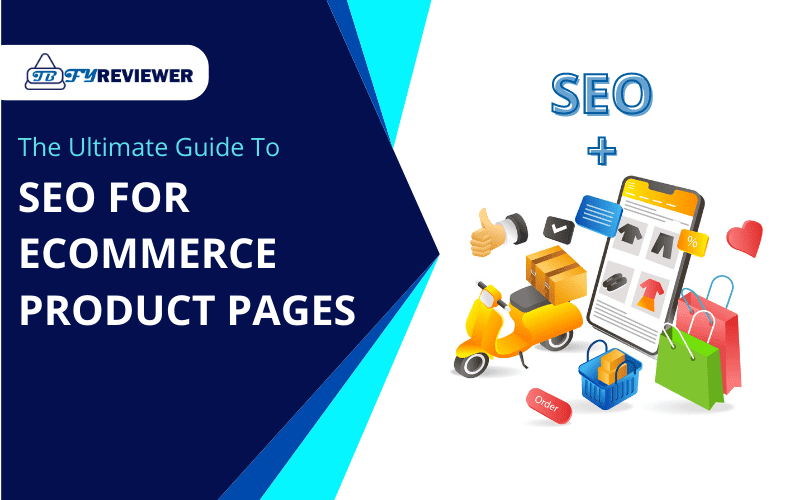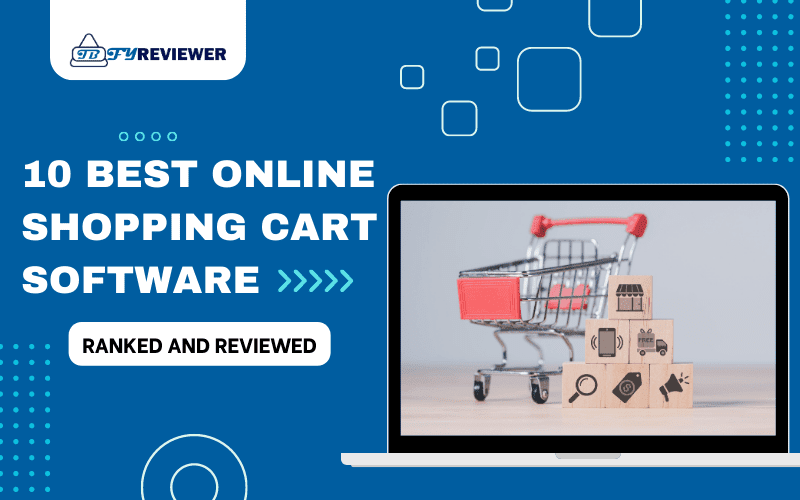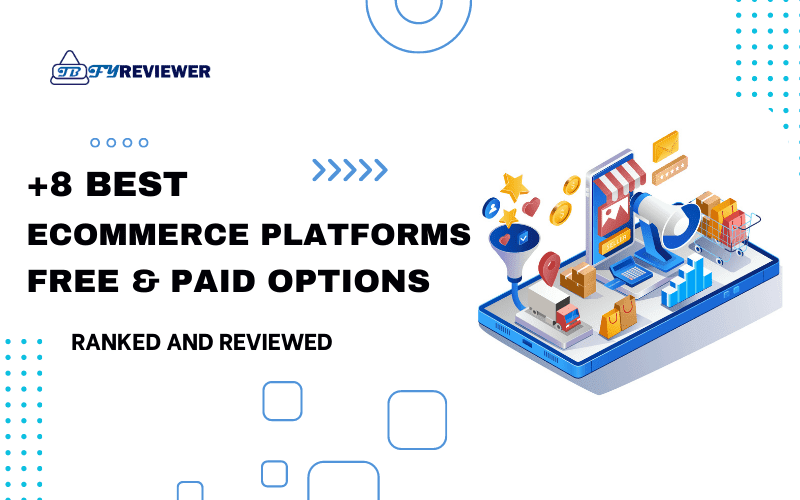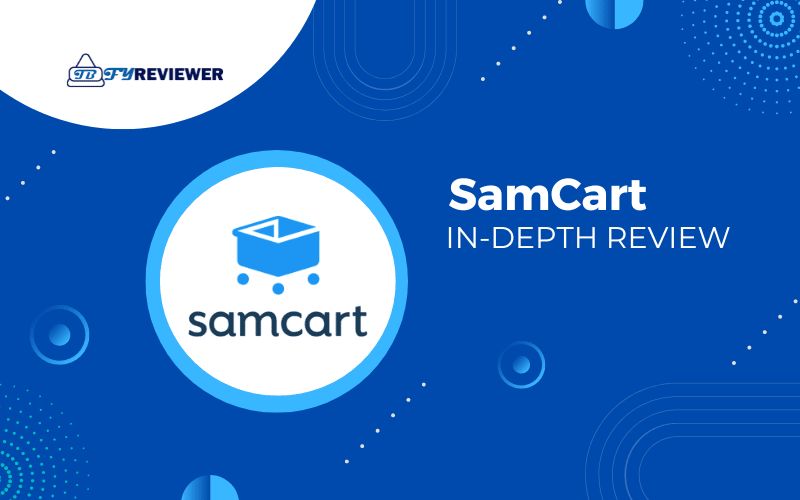Join TbfyReviewer’s newsletter to receive every new article.
How To Create A Winning Ecommerce Strategy: A Complete Guide
Hossam jamjama
- June 7, 2023
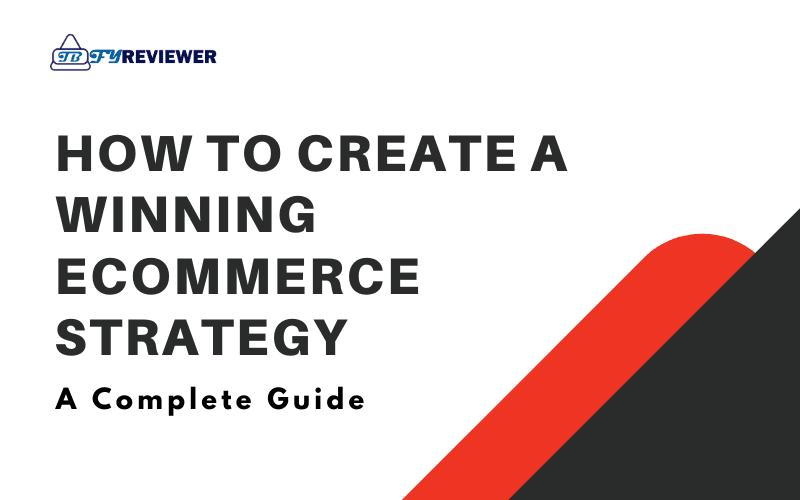
In today’s highly competitive online business landscape, having a solid Ecommerce Strategy is essential for success and growth.
As the rise of ecommerce has made it easier for businesses to reach a larger customer base and increase revenue, creating an effective strategy that sets your business apart from the competition is crucial.
Whether you’re starting a new ecommerce venture or looking to expand your existing one, a well crafted ecommerce strategy can make all the difference.
In this comprehensive article, we will guide you through each step required to create a successful Ecommerce Strategy.
From defining objectives and measurable goals to optimizing your website for search engines and social media, our step by step guide offers essential tips and insights to help you thrive in the ever-evolving world of ecommerce.
Defining Ecommerce Strategy
Before we try to understand how to create a successful ecommerce strategy, let us first define what it is. An ecommerce strategy is a plan of action that outlines all the necessary steps required to achieve goals through online channels.
It includes evaluating the market, customers’ interests, competitors, budget allocation, technology integration, website design & development, marketing & promotion techniques, inventory management, process and operation optimization, and more.
Why a Well-Defined Ecommerce Strategy is Important
Having a well-defined ecommerce strategy can help businesses avoid costly mistakes by providing them with clear guidelines on how they should operate online. It also enables business owners to determine their goals and objectives and plan the actions needed for their realization.
With clear objectives and goals in place, businesses can measure their performance and adjust their ecommerce strategies accordingly.
This type of planning helps businesses build a strong foundation for their online presence which results in heightened brand awareness, increased customer engagement, and ultimately sales growth.
Research and Analysis
The first step in creating an effective ecommerce strategy is conducting thorough research & analysis which includes:
Market Analysis
As an Ecommerce business owner looking to grow your business or establish a new one online, identifying your target market is essential to start right.
The market Analysis covers the following areas.
Identifying the Target Market
You need to identify who your ideal customers are. By having a clear understanding of your target audience’s demographics such as their age group, gender, income range, and geographic location, you can create marketing campaigns that appeal to them.
Competitor Analysis
Another important aspect of market analysis is competition. Identify your key competitors, learn about their strengths and weaknesses, and research their online presence.
This will help you identify strategies that they use successfully for driving traffic and sales.
Conducting a SWOT Analysis
SWOT stands for “strengths, weaknesses, opportunities, and threats”.
Conducting a SWOT analysis not only helps businesses identify their areas of strengths and weaknesses but also highlights any potential opportunities or threats in the market.
Identifying Customer Needs and Preferences
Understanding customer preferences and needs through surveys and past purchase data can help businesses tailor their online offerings accordingly.
Customer interviews can further provide guidance on particular areas of service that need attention.
Business Objectives and Goals
Once research and analyses are complete, it is time to define business objectives and Ecommerce goals aligned with these discoveries.
The objectives must be Specific Measurable Achievable Relevant Time-bound (SMART) with metrics for measuring progress toward achieving them.
This in turn helps choose the right ecommerce marketing strategies for your business.
Budget
Allocating resources should be aligned with business objectives set earlier.
Creating a budget plan for ecommerce business operations serves as a guide in ensuring the best Return On Investment (ROI) possible while balancing costs.
Creating a Budget Plan For Ecommerce Operations
It involves creating an itemized list of expenses based on projections made in each area of ecommerce activities such as ads creation/copywriting, tools/platforms associated costs, shipping costs, stock/inventory costs, etc.
Allocating Funds to Different Areas Of The Ecommerce Business
Allocation of funds should be done based on priority areas identified through SWOT analysis results.
This would ensure that the resources allocated result in maximum impact for the expenses incurred.
Technology & Platform Selection
Choosing the right ecommerce platform is also critical in building the foundation of your online venture. It is important to evaluate available options and keep in mind factors like functionality, scalability, and integration capabilities with other tools and services that will be required for business operations.
Check out our list of the best Ecommerce platforms, and pick the right one for your business.
Choosing the Right Ecommerce Platform
Evaluate different platforms available in the market which provide necessary features like user-friendly design templates, plugin/add-on support and customizations, etc.
Consider choosing a platform with an extensive app store ecosystem to facilitate integrations with different tools and functionalities specific to your ecommerce store.
Technology Integrations & Features
It’s essential to check whether the chosen platform supports all necessary integrations such as payment gateways, shipping software, ERP systems, accounting software, etc.
Also, consider if automated features like abandonment cart notifications or backorder alerts could be used to improve the customer experience.
Website Design and Development
Website design and development should put emphasis on keeping it user friendly.
It should be optimized for mobile allowing quick load time but most importantly based on customers’ needs.
Website Design Essentials for Great User Experience
Your ecommerce website design should prioritize website usability by creating a simplified checkout process.
Pay attention to elements such as a user-friendly interface for navigating to products; concise descriptions and images that accurately depict product details without losing context.
Prioritize mobile responsiveness; easy site navigation, fast load times, easy-to-navigate menus, and search functions.
Technical SEO Best Practices
Technical SEO best practices comprise tactics that can improve page ranking by structuring your content in search engines’ algorithmic ranking methods.
Adequate Title Tags, Meta Descriptions optimized around key phrases related to your business objectives help rank up faster while ensuring vast traffic flow into your site.
Creating Optimized Product Pages
Product descriptions filled with rich texts of information can help boost sales.
Elements such as multiple product images from different angles enhance the credibility of the description giving the possibility of even high revenue turnover.
Marketing and Promotion
Marketing is one of the core pillars of Ecommerce. Promotion techniques should be aligned with targeted objectives. It is worth considering the use of Social media advertising, email marketing, or Pay per click advertising.
Developing Marketing Campaigns for Ecommerce Business
Social Media Advertising, Email Marketing, and PPC are three common direct traffic-generating key channels in mind when developing a marketing campaign.
Creating enticing campaigns with stunning imagery and copy that resonates with your target audience is crucial.
Social Media Advertising
Social media advertising offers targeted reach to an audience through various social platforms like Facebook, Instagram, Twitter, etc.
Ads can be customized by targeting audience demographics which is crucial in promoting the business.
Email Marketing
Email marketing enables personalized communications and can be used to update subscribers about new offerings or promotions through newsletters.
Pay per Click Advertising
PPC is a targeted marketing strategy that allows displaying your ads on search engine result pages (SERPs) for keywords related to your offerings.
By creating compelling copy and targeting specific geographic regions increased Click through rate (CTR) and conversions can be achieved.
Content Marketing Strategies for Ecommerce Sites
Creating blog posts that educate users on the great benefits they receive from the product beings sold or showcasing how it’s better than competitors’ alternative suggestions about how products can be used tends to create trust which leads to sales conversions in return.
Inventory Management
Inventory management refers to the processes involved in managing a company’s inventory levels throughout its supply chain.
The goal of inventory management is to ensure there is adequate stock of products available at any given time.
Efficient Inventory Management Strategies
Different strategies exist for effectively managing inventory levels such as FIFO first in-first out method or LIFO last in-first out method which prioritizes sales of more recently acquired stock.
Allocate resources wisely for each process from receiving inventory shipments to order fulfillment avoiding disordered stockpiles or overstocking where necessary stock items are left unsold.
Automated Inventory Management Systems
Effective inventory management is managing a delicate balance of stock levels.
This can be facilitated by using automation tools with software that collects data and provides a nuanced picture of emerging sales trends over time on the site.
Analysis of accurate data can provide immediate alerts if needed to optimize stock levels.
Processes and Operations
Optimizing order fulfillment is crucial to ensure customer satisfaction: It’s important to track each stage from receiving orders through to delivery and post-delivery support services.
Optimizing Order Fulfillment To Ensure Customer Satisfaction
Accurate order processing minimizes errors, which saves time and money both for business owners and customers.
Consider minimizing processing times from the moment an order is received to when it’s shipped out, the number of touch points associated before it’s dispatched final destination which usually takes longer for foreign destinations.
Customer Service & Support Processes
Offers include easy access to returns or refunds, helpdesk support tickets, or even direct instant messaging in cases where more information is needed leading to higher customer satisfaction ratings.
Analytics, Reporting & Optimization
Monitoring performance analytics can help identify growth potential areas.
Use keyword analysis to focus on related high-important SEO queries and implement optimization techniques for increased search rankings.
Keyword Analysis and Usage Optimization for Higher Search Rankings
Creating relevant content for targeted informative keywords to the target audience is essential in driving traffic and engagement on the ecommerce website. In turn, this would generate higher visibility of your site.
Web Analytics For Data-Driven Decision Making
Analyzing metrics such as conversion rates, traffic sources or user behavior can lead businesses to understand their current performance level whether it’s poor or exceeding expectations.
Based on these insights a detailed action plan can be created with laid-out objectives i.e. increased conversion rates.
Security and Compliance
Taking precautionary measures towards securing transactions made via ecommerce stores will build trust amongst customers leading to more sales as they are confident sensitive data is secure.
Ensuring Secure Transactions
Ensure your website uses SSL certificates and payment gateway integrations for safe transactions.
Any sensitive information pertaining to the business or customers is protected in a way that eliminates chances of hacking thus enhancing trustworthiness amongst users.
Regulatory Compliance
PCI Data Security Standards, California Consumer Privacy Act (CCPA), and General Data Protection Regulation (GDPR) among other lawful tech compliance are relevant to ensuring privacy and safety concerns are met.
Logistics & Shipping
Choosing the perfect shipping carrier based on budgets and deadlines is crucial for business operations as it determines how fast shipments would be received.
Ensuring that your products reach your customers on time and in perfect condition is essential.
Selecting shipping carriers
One of the most important aspects of an ecommerce business is efficient and timely shipping.
Choosing the right shipping carrier can boost your business, but it requires thorough research.
Compare prices from different carriers and ensure they can meet your delivery timelines.
Consider their track record in timely delivery, insurance coverage, and other additional services such as tracking.
Take time to research and compare various shipping options such as USPS, UPS, FedEx, etc, and select carriers that fit your business needs.
Shipping options management on Ecommerce website
Providing customers with multiple shipping options is a great way to increase conversion rates and customer satisfaction.
Make sure your ecommerce website has clear and easy to understand shipping options at checkout. This includes displaying accurate shipping costs and delivery time frames.
Map out the areas you want to offer specific shipping options like free shipping or next-day delivery, then implement them throughout your ecommerce website.
Team Structure & Management
Building an ecommerce business is not a one-man job; it requires a team to execute tasks effectively.
Recruiting a team for ecommerce business
The process of recruiting should include analyzing job roles and requirements while considering candidates’ expertise in those positions.
Building the right team is essential for any ecommerce business to succeed. Identify key roles needed for your business such as web development, content creation, marketing, customer service, etc, and hire individuals with expertise in those areas.
Roles and Responsibilities
A clear delineation of job roles across the organization ensures teamwork with clarity of responsibilities. Know-how performance expectations align with company goals.
The expertise of the Team Members
Compile a team with varying skills that complement each other’s expertise to maximize productivity and efficiency.
Identify individuals who have experience in various aspects related to businesses e.g social media marketing or email writing etc.
Team training needs and management
Investing in employee training can result in better productivity and efficiency of work within your team members which has overall effectivity on the whole organization.
Conduct frequent training sessions to keep up to date on current trends in technology, marketing strategies, data management, and social media advertising campaigns, among others.
Returns and Refunds Management
The returns process can be stressful for customers, especially if the refund process is confusing.
Thus, handling returns professionally and seamlessly is essential in ecommerce.
Creating a hassle-free returns process
Returns and refunds are an inevitable part of any ecommerce business, so creating a simple and hassle-free return process is essential for customer satisfaction.
Make sure your return policy is clearly stated on your website, including instructions on how to initiate a return or exchange of items, shipping labels, and refund expectations.
Implementing automated returns management systems would make it easier than ever.
Efficient refunds management procedures
It’s important to have an efficient refund management procedure that ensures maximum customer satisfaction e.g by issuing immediate refunds when required.
Set up a business system or software platform that enables you to receive, evaluate, and approve returns quickly.
Automate your refund processes for faster decision making and notify customers through emails at every stage.
Online Tools and Resources to Use in Ecommerce Strategy
In addition to logistics, team structure, and returns management, various online tools and resources can help streamline your ecommerce business.
Email Marketing tools
Email marketing software is a powerful tool for reaching new customers and nurturing existing relationships.
Use email marketing platforms such as AWeber, Sendinblue, or ConvertKit for sending newsletters, promotional offers, and follow-up emails.
Ecommerce Platforms
Consider using ecommerce platforms such as BigCommerce, Nexcess, or Shift4Shop, which offer ready to use templates for setting up an online store.
These platforms provide inventory management, order processing, shipping solutions, and payment gateways.
CRM Systems
Integrating CRM systems such as Monday, HubSpot or Keap CRM can organize customer data effectively to enhance customer experiences at every touchpoint.
Shopping Cart Software
Shopping cart software like SamCart and ThriveCart can improve the online shopping experience of your customers by offering easy navigation systems with user-friendly visuals optimized for mobile devices.
Summary:
With the right combination of these online tools and resources tailored to your ecommerce business needs, you’ll achieve a more streamlined operation with greater visibility into vital aspects of your organization that continues to grow.
Conclusion
In summary, a successful Ecommerce Strategy involves a comprehensive analysis of the business structure. The key components that need examination are logistics, shipping systems, team building, and returns processing.
By choosing the appropriate carriers, developing a skilled team that works efficiently, and creating a hassle-free returns process with streamlined refund management, you can establish a strong foundation for your online business.
Continuously assess your strategy as time goes on to make necessary adjustments for optimal results and keep an eye on market trends.
Start crafting your Ecommerce Strategy today and maximize your online success.
- Last Update OnJune 7, 2023
- ByHossam jamjama

Hossam Jamjama
Hey, it’s Hossam. I am a full time digital marketer & an online business owner. I write guides and in-depth reviews of the best SaaS products available. To help businesses make informed decisions about picking the right one for them.
Disclosure: TbfyReviewer is a participant in various affiliate programs, which means we may earn a commission when you buy something through links on our site at no cost to you if you decide to purchase a paid plan. You can read our affiliate disclosure.
Table Of Content
- Defining Ecommerce Strategy
- Why a Well-Defined Ecommerce Strategy is Important
- Research and Analysis
- Business Objectives and Goals
- Budget
- Technology & Platform Selection
- Website Design and Development
- Marketing and Promotion
- Inventory Management
- Processes and Operations
- Analytics, Reporting & Optimization
- Security and Compliance
- Logistics & Shipping
- Team Structure & Management
- Returns and Refunds Management
- Online Tools and Resources to Use in Ecommerce Strategy
- Conclusion

